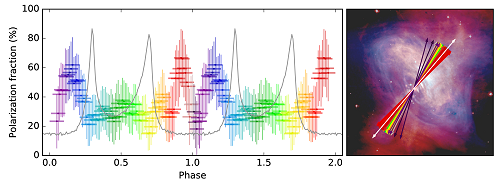India’s multi-wavelength space telescope AstroSat discovers a strange polarisation in the Crab Nebula. Indian scientists have documented the results of their 18-month study of the Crab pulsar in the Taurus constellation and measured the variations of polarisation. This landmark measurement puts up a strong challenge to prevailing theories of high energy X-ray emission from pulsars.
Pune (ISJ) – India’s multi-wavelength space telescope AstroSat has discovered a strange polarisation in the Crab Nebula. In a paper published in the latest edition of Nature Astronomy, Indian scientists have documented the results of their 18-month study of the Crab pulsar in the Taurus constellation and measured the variations of polarisation. This landmark measurement puts up a strong challenge to prevailing theories of high energy X-ray emission from pulsars.
The Crab Nebula is a supernova remnant in the constellation of Taurus. The ghostly remains of a massive stellar explosion known as supernova was observed in 1054 AD. The Crab Nebula spans about 10 light-years. In the nebula’s very center lies a pulsar: a neutron star as massive as the Sun but with only the size of a small town. The Crab Pulsar rotates about 30 times each second.
Several exotic objects in the universe, with extremely large mass condensed in a very small volume, possess extremely strong gravitational and magnetic fields, both approximately trillion times that on the Earth. They are known to be sources of intense X-ray radiation, electromagnetic waves similar to light. But these waves have ten to hundred thousand time higher energy, which carries vital clues to understand them as also the physical processes responsible for radiation.
Astronomers have extensively studied various properties of this radiation to piece together a complete picture of compact objects and their immediate surroundings. However, the puzzle often remains incomplete due the missing information about the elusive properties of X-rays known as polarization.
Indian scientists using data from the CZT Imager instrument of the AstroSat satellite have performed the most sensitive measurement of X-ray polarisation of the Crab pulsar, the rotating neutron star which is the main energy source of the nebula. These measurements have, for the first time, enabled the study of polarization at different rotation phases of the pulsar. The findings are a serious challenge to most of the current theories of how the object produces X-rays.
“This is a big challenge to theorists,” said Prof. Dipankar Bhattacharya of Inter University Centre for Astronomy and Astrophysics (IUCAA), Pune. “It tells us that the pulsar emission extends into what was thought to be off pulse region.”
The CZT Imager (CZTI) instrument derives its name from the detectors that make up its heart, made of a semiconductor called “Cadmium Zinc Telluride”. It consists of 16384 tiny pixels, essentially independent detectors, to measure X-rays coming from the celestial objects. When high energy X-rays shine on these detectors, an extremely small electric signal is generated, which is further processed to measure the energy of the photon. The incident X-ray photon sometimes leaves a signal in two neighbouring pixels, due to an effect called “Compton scattering”. For regular X-ray light, the orientation of these neighbours is random. But if you start seeing more and more of these two-pixel pairs aligned in the same direction, then it is a signature of polarized photons.
“The idea of using pixelated CZT detectors for X-ray polarization measurement has been around for a while, but this is for the first time that this idea was tested on ground before launch and then employed in space. This makes our measurements much more credible. Another important feature of our measurements is the study of polarization properties at different rotation phases of the pulsar, which has not been done so far,” said Prof. Santosh Vadawale of PRL Ahmedabad, the lead author of the paper, who is part of the CZTI team. CZTI is the only functional space telescope whose polarisation abilities were measured before launch.
“It was a massive ground-calibration effort. We have detailed files on each and every one of the sixteen thousand pixels of CZTI,” said Prof. Varun Bhalerao of IIT Bombay.
CZT-Imager is built by a consortium of Institutes – Tata Institute of Fundamental Research (TIFR), Mumbai, Vikram Sarabhai Space Centre, Thiruvananthapuram, ISRO Satellite Centre (ISAC), Bengaluru, Inter-University Centre for Astronomy and Astrophysics (IUCAA), Pune, Space Application Centre (SAC) at Ahmedabad and Physical Research Laboratory (PRL), Ahmedabad.


